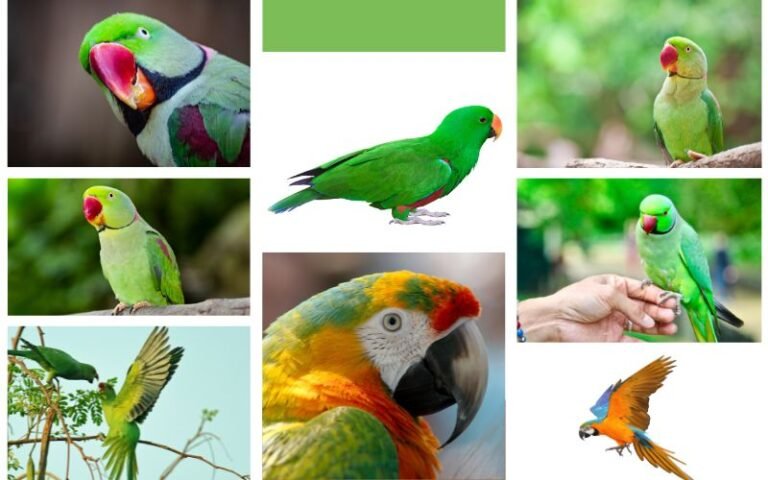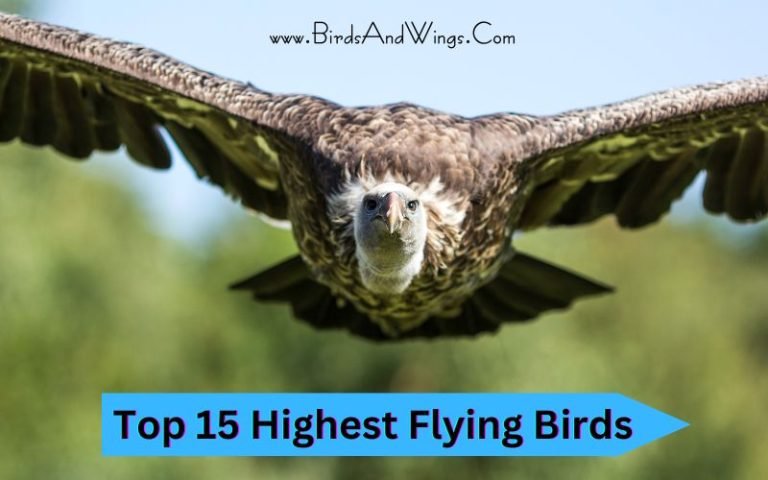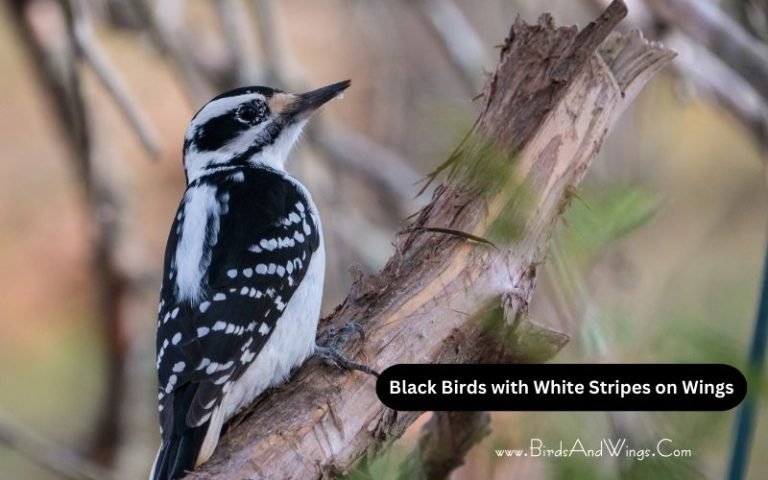20 Yellow Birds With Black Wings
In the wonder of avian species, birds with diverse plumage contain eye-catching appearances for humans. Birds with a yellow and black combination of plumage hold magnetic, charming, and captivating features among other species.
This article will evaluate the top 20 yellow birds with black wings. It also discusses these 20 bird species’ individual characteristics, such as scientific names, size, native place, lifespans, wingspan, and diets, along with their other facts.
20 Yellow Birds With Black Wings
Yellow Birds With black wings hold magnificent appearances which attract humans or any bird watchers towards them.
This section will discuss their characteristics, such as scientific names, size, native place, lifespans, wingspan, and diets, along with their physical descriptions, distribution, habitats, behavior, breeding seasons, and other attributes of nature.
Bird 1: American Goldfinch

- Scientific name: Spinus tristis
- Lifespan: 3 to 6 years
- Wingspan: about 19–22 cm (7.5–8.7 in)
- Native to: North America
- Size: 1–14 centimeters (4.3–5.5 in)
- Food or Diet: seeds, weeds, grasses, buds, berries, flowers like dandelion, cosmos, goatsbeard, sunflower
American Goldfinch is a small bird related to the Finch family. Its whole body is yellow, its forehead is black, and its wings have black stripes.
They have small pinkish beaks that later change into orange during their molting process. These American goldfinches usually molt twice a year, and their whole body features shed different colors.
These birds are mostly native to North America, including Alberta North Carolina, Canada, and the United States. These American goldfinch birds prefer open country-like fields, floodplains, roadsides, woodlands, orchards, and gardens for their habitats.
They inhabit mostly in the spring and migrate during the autumn. These birds make some defense calls to avoid and sense their predators from their nesting sites.
When males find their mates, they select their nesting sites; later, female goldfinches build a nest that is up to 33 feet higher than ground level.
Bird 2: Audubon’s Oriole

- Scientific name: Icterus graduacauda
- Lifespan: not found
- Wingspan: about 12.6 inches (32 cm)
- Native to: Southern Texas and Mexico coast
- Size: 7.5-9.5 inches
- Food or Diet: insects, spiders, fruits, sunflower seeds, etc.
Audubon orioles, also known as black-headed orioles, are small passerine birds. Their bodies are covered with yellow and black plumage, with a fully black head and beak and yellow upper parts, chests, and bellies.
Their wings also have black plumage with white flight feathers. Female orioles are more olive-colored than male birds.
These species are widely common in the Texas and Mexican coast regions, where they prefer dense evergreen forests and thick riverside areas for their habitats. These orioles mix with other small passerine birds like jays and tanagers and flock together.
These birds incubate two broods per year, each containing 3 to 5 eggs. Young birds from the later broods cannot survive because of the winter season.
Their small beaks can be inserted into any softwood or plant, and insects can hide inside it.
Bird 3: Black-Throated Green Warbler

- Scientific name: Setophaga virens
- Lifespan: around 6 years
- Wingspan: around 6.7–7.9 inches (17–20 centimeters)
- Native to: America
- Size: around 4.3–4.7 in (11–12 cm)
- Food or Diet: insects, caterpillars, buds and berries
Black-throated green warbler birds are small yellow birds that have black throats. Their wings also have a black and white pattern with black bills and black Irish.
They have an olive green forehead and a yellow face. These warbler birds are common in America and breed on the North American, western Canada, and southern Atlantic coasts.
Later, these birds migrate to Mexico, Central America, the West Indies, and southern Florida. They prefer mixed forests and vegetation for their inhabitants.
Their main food is insects, such as ants, bees, butterflies, etc. However, they sometimes eat fruits, such as berries. Female warblers build 3-10′ nests in a tree. Later, they lay 3 to 5 tiny eggs and incubate them for 12 days.
Bird 4: Common Yellowthroat

- Scientific name: Geothlypis trichas
- Lifespan: around 10 years
- Wingspan: about 5.9–7.5 inches (15–19 centimeters)
- Native to: North America
- Size: 4.3–5.1 in (11–13 cm)
- Food or Diet: insects, spiders, flowers, fruits
Common yellowthroat birds are also known as yellow bandits or Maryland yellow throats. They are small songbirds with olive backs, tails, wings, bright yellow throats, chests, and white belly.
Adult males have black faces, black Irish, and bills. These birds are related to the New World warbler family and are highly distributed in the North American region, including Canada, central Mexico, and the West Indies.
These yellowthroat birds are very rare in European countries. However, they prefer marshes, wet areas, and low-density vegetation in their habitats.
Females build cup-shaped nests and lay 3 to 5 eggs in them. Both parents feed their young together. Yellowthroat birds are nocturnal migrants, which means they only migrate at night. They migrate to Canada, the Western, Eastern, and Central U.S. regions.
Bird 5: Eastern Meadowlark

- Scientific name: Sturnella magna
- Lifespan: around 5 years
- Wingspan: 35–40 cm (14–16 in)
- Native to: North America and South America
- Size: 19 – 28 centimeters (7.5 to 11.0 in)
- Food or Diet: Arthropods, seeds, grains, berries, beetles, grasshoppers etc.
Eastern meadowlarks are medium-sized birds related to the Icteridae family. Adult birds have yellow underparts with v-shaped black plumage and brownish-black backs and wings.
They also have long-pointed bills. These birds are mostly native to North and South America. They prefer grasslands and hay (grass) fields for their habitats.
Their nesting season lasts for the summer month. Female birds build their cup-shaped nests on the grounds around 1 to 3 inches deep with dried grass, plant stems, horse hairs, and roof woven.
Females lay 3 to 5 white eggs there. Later, female meadowlarks incubate the eggs for 13 to 15 days until they hatch.
Bird 6: Evening Grosbeak

- Scientific name: Hesperiphona vespertina
- Lifespan: 15 years
- Wingspan: around 30-36 centimeters (12 inch -14 inch)
- Native to: North America
- Size: about 16-22 cm (6.3 into 8.7 in)
- Food or Diet: seeds, fruits, and insects
Evening grosbeaks are small passerine birds related to the finch family. They have yellow foreheads and bodies, short black wings, and pale bills.
These species are highly distributed in North America, including coniferous, Canada, the United States, and Mexico. In winter, these birds migrate or travel through the southern United States.
These birds mostly breed in mixed forest areas across Canada, the Western mountains of the United States, and Mexico. They mainly forage in trees and bushes.
The female grosbeak birds usually lay 3 to 4 blue-brown spotted eggs. Later females incubate for 12 to 14 days until the eggs hatch.
Bird 7: Golden Crowned Kinglet

- Scientific name: Regulus satrapa
- Lifespan: around 6.3 years in the wild
- Wingspan: around 5.5-7.1 inches (14-18 centimeters)
- Native to: North America
- Size: around 8-11 centimeters (3.1 in-4.3 in)
- Food or Diet: insects eggs, fruits, and spiders
Golden-crowned kinglet birds are small passerine songbirds related to the Regulidae family. These birds are highly spotted in North America, including coniferous, Canada, the United States, Mexico, and Central America.
Adult kinglet birds have olive-gray plumage on their back with white wing bars. They have black stripes around their eye areas and have yellow-black patches on their forehead with a thin black bill.
During their non-breeding seasons, these birds migrate to the United States. These kinglet birds are fond of mountainous regions filled with coniferous trees and also prefer mixed forest areas for their habitats.
Golden-crowned kinglet birds build 3″×3″ size cup-shaped nests in trees. Female kinglets in the nests lay 7 to 8 eggs in white, brown, and legendary colors. Later, female birds incubate the eggs for 15 days until they hatch.
Bird 8: Hooded Oriole

- Scientific name: Icterus cucullatus
- Lifespan: 3 to 5 years
- Wingspan: 9.1- 11 inches
- Native to: North America, United States, Mexico
- Size: around 7 inches
- Food or Diet: nectar, insects, fruits and flowers
Hooded orioles are medium-sized birds related to the New World oriole family species. Adult orioles have black bills that are slightly curved towards the ground.
Their heads are yellowish-orange, and their faces, throats, wings, and tails are black. The adult female birds have olive green plumage on their underparts and yellowish breasts and belly.
These birds prefer open areas with trees, especially palm trees, as their habitats. During their migration seasons, they form groups or colonies and migrate to the Southwestern coast in those flocks.
These birds made cup-shaped nests, in which female birds laid 3 to 5 eggs. Later, the female birds incubated the eggs for about 12- 14 days. After hatching, the Young left their nests within 14 days.
Bird 9: Lesser Goldfinch

- Scientific name: Spinus psaltria
- Lifespan: around 5 to 6 years
- Wingspan: about 5.5 to 7 cm (2.2 to 2.8 in)
- Native to: America
- Size: around 9 – 12 cm (3.5 to 4.7 in)
- Food or Diet: fruits, seeds, buds, insects, berries, etc.
Lesser goldfinch birds are small songbirds related to the American goldfinch and Lawrence goldfinch families, which belong to the world goldfinch family.
Male finches have bright yellow underparts with white striped tails. Their wings are dark brown with a white bar on them with a blackish-brown patch on the head.
Adult females have olive green plumage over their body with a yellowish lower abdomen. These finches are widely distributed in America, including the United States, Washington, Venezuela, and Peru.
Later, they migrated to the colder regions of the United States. These birds prefer trees or shrubs for their habitats. Their nesting seasons begin during the summer seasons.
These birds shed their feathers twice a year. Few birds molt after breeding, and some females molt before the breeding season.
Bird 10: Magnolia Warbler

- Scientific name: Setophaga magnolia
- Lifespan: around 7 years
- Wingspan: around 16 – 20 centimeters (6.3 to 7.9 in)
- Native to: North America
- Size: almost 11-13 cm (4.3 to 5.1 in)
- Food or Diet: arthropods, caterpillars, beetles, spiders, fruits, nectar, plants, etc.
Magnolia warblers are a similar species of the wood warbler family, mostly familiar in the Northeastern parts of the United States, Canada, Mexico, and Central America.
These birds prefer dense forests and coniferous trees for their habitats. These birds migrate to warmer places in the south, Mexico, Panama, and the Caribbean during the winter.
These species have yellow lower parts with brown stripes and grayish-white upper parts with white rings around the eyes. These warbler birds molt or shed multiple times during their entire lives.
Male magnolia birds reach the breeding sites before the female magnolias. Females made circle-shaped nests with grass, twigs, horsehair, and fungus. In the nest, female magnolia birds lay 3 to 5 eggs.
Female birds do not sit for the incubation process until all the eggs are laid properly.
Bird 11: Orchard Oriole

- Scientific name:Icterus spurius
- Lifespan: 9 years
- Wingspan: around 9.8 in (25 cm)
- Native to: Canada, United States, Venezuela, Colombia
- Size: up to 5.9-7.1 in (15-18 cm)
- Food or Diet: insects, spiders, fruits, nectar, seeds
Orchard oriole birds are the smallest bird species of the Icterid family. Adult orioles have black bills, heads, shoulders, and tails with orangish-yellow lower parts.
These birds are mostly native to the United States, Canada, Baja California Sur, Venezuela, and Northern America. They prefer semi-open areas, deciduous trees, lakes, and streams for their habitats.
Their winter habitats usually start in March and April. Later, their breeding season starts in April to late May. After a successful breeding season, these species leave those places between July and early August.
During their courtship days, female birds display while bowing their heads, raising and lowering their heads and tails, and making whistling sounds to attract their male partners.
Bird 12: Baltimore Oriole

- Scientific name: Icterus galbula
- Lifespan: around 12 years in the wild; 14 years in captivity
- Wingspan: about 23–32 cm (9.1–12.6 in)
- Native to: North America
- Size: 17–22 cm (6.7–8.7 in)
- Food or Diet: fruits, insects, caterpillars, seeds, berries, etc.
Baltimore orioles are small birds in the Icterid family. Adult birds are slightly larger than female birds. They have yellow-orange lower parts and blackheads and shoulders.
Their wings are also black with white stripes. These species of oriole are familiar in North America, including the United States, South America, Central America, and the Southern coasts.
These birds are very rare in the western European region. They do not prefer deep forests; rather, they prefer wooded areas, orchards, farmlands, coffee plantations, wetlands, and leafy deciduous trees for their habitats.
Male orioles sing loud whistles with buzzing sounds to communicate with their fellow members. Female Baltimore builds their nests and lays 3 to 7 eggs. The incubation process lasts 12 to 14 days.
Bird 13: Western Tanager

- Scientific name: Piranga ludoviciana
- Lifespan: around 8 years; 15 years in captivity
- Wingspan: 11.5 in (29 cm)
- Native to: America; north, south, and central
- Size: 6.3-7.5 in (16-19 cm)
- Food or Diet: fruits, berries, insects
Western tanager birds are the subspecies of tanager birds also related to the Cardinalidae family. Adult males have reddish-yellow heads with black upperparts and yellow underparts.
Their beaks are pale, stout, and pointed, with light wing bars. Female tanagers have a yellow head, olive body, and dark wings and tails.
These species’ breeding range cover North America, southeastern Alaska, north Baja California, Mexico, western Texas, and central New Mexico. Western tanager birds prefer open coniferous forests, mixed woodlands, deserts, oases, parks, and orchards for their habitats.
Sometimes, western tanagers migrate alone, or they may form a group of 30 birds. Generally, their migration period starts in the middle of August.
They build their nests around 10 feet higher than ground level. Female tanagers make their nests mostly cup-shaped.
Bird 14: Scarlet Tanager (Female)

- Scientific name: Piranga olivacea
- Lifespan: around 10-12 years
- Wingspan: 9.8 inches -11.8 inches
- Native to: Eastern North America, South America
- Size: around 16 -19 cm (6.3 – 7.5 in)
- Food or Diet: mainly insects, wasps, bees, ants, snails, worms and some fruits
Scarlet Tanagers are a similar subspecies of tanager birds belonging to the Cardinalidae family. Both females and males have smoothing bills of a pale color.
Females have olive, yellowish plumage with blackish-brown wings. In the North American region, these species prefer deciduous forests, oak trees, parks, suburban areas, and cemeteries for their habitats.
They reach their breeding spot in May to early June. Females reach their breeding spots several days later. Females build nests and lay four eggs in a light blue color.
Later, female birds incubate the eggs for about 11 to 14 days. After hatching, the young birds leave their nest by 9 to 12 days and can fly fully.
Sometimes, they fly around to catch their prey, and they are even spotted on the forest grounds or floor to search for food.
Bird 15: Wilson’s Warbler

- Scientific name: Cardellina pusilla
- Lifespan: around 6 years
- Wingspan: around 14–17 centimeters (5.5 inches –6.7 inches)
- Native to: North America
- Size: around 10-12 centimeters (3.9 to 4.7 in)
- Food or Diet: Wilson’s warbler insects, bees, caterpillars
Wilson’s warbler birds are small birds related to the New World warbler family. These birds have olive-greenish plumage and yellow faces with small black caps on the head.
These species are mostly familiar in Canada and the Western United States. These birds prefer woodlands, shrubs, moist areas, ponds, bogs, coffee plantations, tropical evergreens, and pine-oak trees for their habitats.
However, these species are also very rare in Western Europe. These bird’s breeding seasons generally start from March and last till August.
The female warblers build the maximum of their nests with grasses and hairs. Later female birds lay 2 to 7 off white creamy eggs and incubate the eggs for 8 to 13 days.
Bird 16: American Yellow Warbler

- Scientific name: Setophaga petechia
- Lifespan: around ten years
- Wingspan: around 6.3-8.7 inches
- Native to: North America, Caribbean, South America
- Size: 3.9 inches -7.1 inches
- Food or Diet: insects, caterpillars, beetles, fruits, etc.
American yellow warbler birds are also a similar species of warbler and are related to the New World Warbler family. These species’ whole body is covered with yellow plumage, and wings are slightly greenish-gray plumage.
They are mostly familiar in North America, the Caribbean, and northern South America, including bushes, swamps, and gardens for habitats. Yellow warbler birds’ breeding seasons start in between May and June.
Their nests contain 3 to 6 eggs laid by female warblers. The females incubate those eggs for around 11 days. After hatching from the eggs, the young depend on their parents fully.
These birds can produce musical sounds like sweet, sweet, sweet; besides defending their territories, they also give hissing sounds.
Bird 17: Yellow-Headed Blackbirds

- Scientific name: Xanthocephalus xanthocephalus
- Lifespan: around 11 years
- Wingspan: around 16.5-17.3 inches (42-44 centimeters)
- Native to: North America, United States, Mexico,
- Size: around 8.3-10.2 inches (21-26 centimeters)
- Food or Diet: prime food: seeds, insects, and fruits.
Yellow-headed blackbirds are a subspecies of the blackbird family. Their whole body has dark black plumage with yellow heads and black bills.
These species are familiar in the United States and Mexico, including the Colorado River, Arizona, and San Joaquin Valley. During their breeding seasons, male birds arrive earlier than female birds.
During the breeding seasons, male birds become more protective of their nests and territories. They try to defend their nests and territories by displaying and chasing off intruders and predators.
These species also form a group outside their species and roam with those groups for breeding purposes and food sources.
Bird 18: Summer Tanager (Female)

- Scientific name: Piranga rubra
- Lifespan: around 5 years
- Wingspan: 28 – 30 centimeters
- Native to: Southern states, Mexico, Central America, and South America
- Size: 17 cm (6.7 inches)
- Food or Diet: prime food insects, beetles, cicadas, caterpillars, grasshoppers, bugs, flies and spiders
Summer tanager birds are also classified as the Cardinalidae family’s birds. Adult female birds have orangish underneath and olive upper parts with olive-brown wings and tails.
These species are familiar in the southern United States, Mexico, Central America, and South America. However, they are hardly found in Western European countries.
They prefer wooded areas, mostly oaks, for their habitats. During winter, they live in lowlands, forest edges, and scattered trees.
They sometimes forage in high trees to catch their food and even fly out to catch insects. Their prime food is insects, bees, wasps, and berries.
Bird 19: Western Kingbird

- Scientific name: Tyrannus verticalis
- Lifespan: about 6 years
- Wingspan: 15.5 inches
- Native to: North America
- Size: 8-9.3 inches
- Food or Diet: insects, wasps, bees, butterflies, leafhoppers, grasshoppers, spiders, caterpillars, fruits, etc.
Western kingbirds are medium-sized birds mostly familiar in Western North America, including Mexico. They have yellow underparts and dark brown plumage, a gray head, and black bills.
These birds prefer open areas for their habitats. Western kingbirds are identified for their aggressiveness and protectiveness toward their territories and nesting sites.
They can attack humans, pets, and other living things if they feel their nesting sites or their young are in danger. Female kingbirds make cup-shaped nests in trees or shrubs.
Female birds lay 3 to 5 pinkish creamy eggs and incubate for 12 to 14 days.
Bird 20: Scott’s Warbler

- Scientific name: Icterus parisorum
- Lifespan: not found
- Wingspan: around 12.6 inches (32 cm)
- Native to: United States, California Sur, Mexico,
- Size: 9.1 inches (32-41 cm)
- Food or Diet: moths, butterflies, bees, wasps, stoneflies, bugs, spiders, etc.
Scott’s orioles are medium-sized birds related to the Icterid family. Their lower parts are yellow, and their heads, shoulders, and wings are black. Their wings have white bars on them.
These warbler birds are mostly familiar in the southwestern United States, Baja California Sur, Central Mexico, and California.
These species prefer foothills, mountains, and desert areas for their habitats. Female warblers lay 1 to 5 pale blue eggs and incubate the eggs for several weeks until they hatch.
Conclusion
In short, these 20 yellow birds with black contrasting plumage mesmerize humans or any bird enthusiast with their divine beauty and charismatic appearance on earth.
People become more curious, which makes them interested in these wonderful species of nature. Likewise, birds with orange breasts, speckled breasts, black birds with orange beaks, and blue and black birds enhance the diverse color contrasts of avian species.







